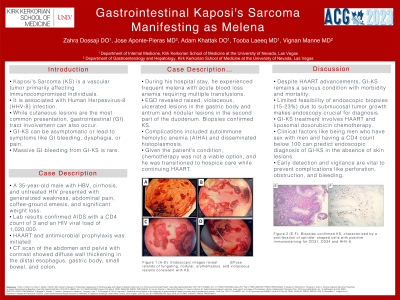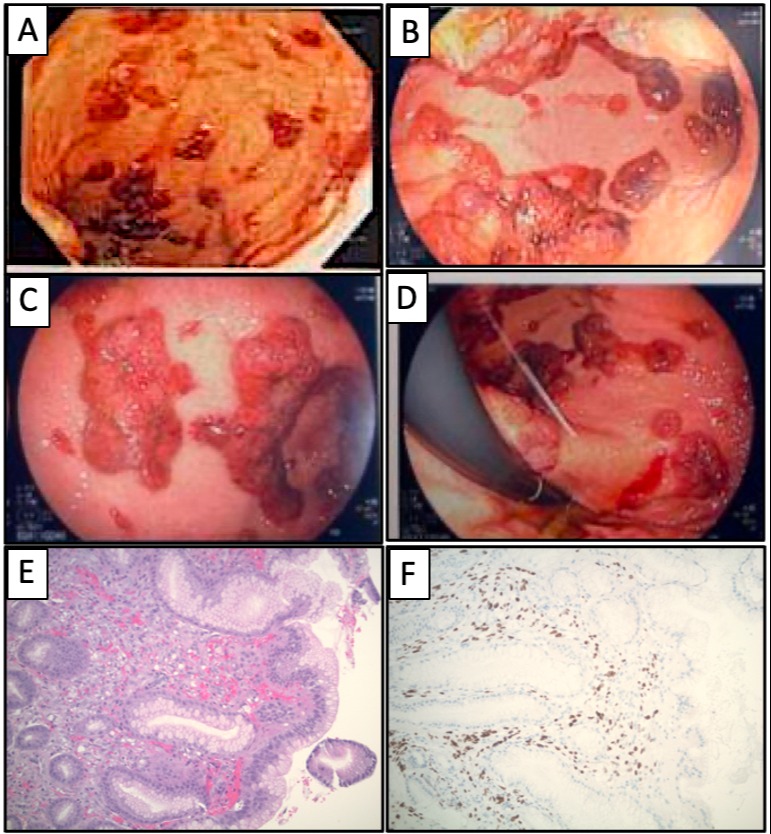Tuesday Poster Session
Category: GI Bleeding
P3472 - Gastrointestinal Kaposi's Sarcoma Manifesting as Melena
Tuesday, October 24, 2023
10:30 AM - 4:00 PM PT
Location: Exhibit Hall

Has Audio

Zahra Dossaji, DO
Kirk Kerkorian School of Medicine at UNLV
Las Vegas, NV
Presenting Author(s)
Zahra Dossaji, DO1, Jose Aponte-Pieras, MD1, Blaine Massey, DO1, Adam Khattak, DO1, Tooba Laeeq, MD2, Vignan Manne, MD1
1Kirk Kerkorian School of Medicine at UNLV, Las Vegas, NV; 2University of Nevada, Las Vegas, Henderson, NV
Introduction: Kaposi's Sarcoma (KS) is a vascular tumor primarily affecting immunocompromised individuals and is associated with Human Herpesvirus-8 (HHV-8) infection. While cutaneous lesions are the most common presentation, gastrointestinal (GI) tract involvement can also occur. GI-KS can be asymptomatic or lead to symptoms like GI bleeding, dysphagia, or pain. Massive GI bleeding from GI-KS is rare. Here, we present a case of a patient with AIDS who was diagnosed with gastrointestinal Kaposi Sarcoma after presenting with melena.
Case Description/Methods: A 35-year-old male with Hepatitis B, cirrhosis, and untreated HIV presented with generalized weakness and abdominal pain. He reported coffee-ground emesis and a 60 lb. weight loss. Physical exam did not reveal skin lesions. Further evaluation revealed AIDS, with lab results including a hemoglobin of 9.1, CD4 count of 3, and an HIV viral load of 1,020,000. A CT scan of the abdomen and pelvis with contrast showed diffuse wall thickening in the distal esophagus, gastric body, small bowel and colon.
He was initiated on highly active antiretroviral therapy (HAART) along with antimicrobial prophylaxis. During his hospital stay, he experienced frequent melena with acute blood loss anemia requiring multiple transfusions. An upper endoscopy revealed raised, violaceous, ulcerated lesions in the gastric body and antrum, as well as nodular lesions in the second part of the duodenum. Biopsies confirmed KS, characterized by a proliferation of spindle-shaped cells with positive immunostaining for CD31, CD34 and HHV-8.
Hospital course was complicated by autoimmune hemolytic anemia (AIHA) and disseminated histoplasmosis. High-dose steroid therapy was initiated for AIHA, but it worsened the melena. The patient was a poor candidate for chemotherapy and was eventually transitioned to hospice care while remaining on HAART.
Discussion: While the incidence of GI-KS has decreased with the advent of HAART, it still carries significant morbidity and mortality. Endoscopic biopsy is feasible in only 15-23% of cases due to submucosal tumor growth, making endoscopy crucial for diagnosing upper GI-KS. Treatment for GI-KS involves HAART and systemic chemotherapy with liposomal doxorubicin. Certain clinical factors, such as being men who have sex with men and having a CD4 count below 100, can predict endoscopic diagnosis of GI-KS in the absence of skin lesions. Early detection and low suspicion of GI-KS are vital to prevent complications such as perforation, obstruction, and bleeding.

Disclosures:
Zahra Dossaji, DO1, Jose Aponte-Pieras, MD1, Blaine Massey, DO1, Adam Khattak, DO1, Tooba Laeeq, MD2, Vignan Manne, MD1. P3472 - Gastrointestinal Kaposi's Sarcoma Manifesting as Melena, ACG 2023 Annual Scientific Meeting Abstracts. Vancouver, BC, Canada: American College of Gastroenterology.
1Kirk Kerkorian School of Medicine at UNLV, Las Vegas, NV; 2University of Nevada, Las Vegas, Henderson, NV
Introduction: Kaposi's Sarcoma (KS) is a vascular tumor primarily affecting immunocompromised individuals and is associated with Human Herpesvirus-8 (HHV-8) infection. While cutaneous lesions are the most common presentation, gastrointestinal (GI) tract involvement can also occur. GI-KS can be asymptomatic or lead to symptoms like GI bleeding, dysphagia, or pain. Massive GI bleeding from GI-KS is rare. Here, we present a case of a patient with AIDS who was diagnosed with gastrointestinal Kaposi Sarcoma after presenting with melena.
Case Description/Methods: A 35-year-old male with Hepatitis B, cirrhosis, and untreated HIV presented with generalized weakness and abdominal pain. He reported coffee-ground emesis and a 60 lb. weight loss. Physical exam did not reveal skin lesions. Further evaluation revealed AIDS, with lab results including a hemoglobin of 9.1, CD4 count of 3, and an HIV viral load of 1,020,000. A CT scan of the abdomen and pelvis with contrast showed diffuse wall thickening in the distal esophagus, gastric body, small bowel and colon.
He was initiated on highly active antiretroviral therapy (HAART) along with antimicrobial prophylaxis. During his hospital stay, he experienced frequent melena with acute blood loss anemia requiring multiple transfusions. An upper endoscopy revealed raised, violaceous, ulcerated lesions in the gastric body and antrum, as well as nodular lesions in the second part of the duodenum. Biopsies confirmed KS, characterized by a proliferation of spindle-shaped cells with positive immunostaining for CD31, CD34 and HHV-8.
Hospital course was complicated by autoimmune hemolytic anemia (AIHA) and disseminated histoplasmosis. High-dose steroid therapy was initiated for AIHA, but it worsened the melena. The patient was a poor candidate for chemotherapy and was eventually transitioned to hospice care while remaining on HAART.
Discussion: While the incidence of GI-KS has decreased with the advent of HAART, it still carries significant morbidity and mortality. Endoscopic biopsy is feasible in only 15-23% of cases due to submucosal tumor growth, making endoscopy crucial for diagnosing upper GI-KS. Treatment for GI-KS involves HAART and systemic chemotherapy with liposomal doxorubicin. Certain clinical factors, such as being men who have sex with men and having a CD4 count below 100, can predict endoscopic diagnosis of GI-KS in the absence of skin lesions. Early detection and low suspicion of GI-KS are vital to prevent complications such as perforation, obstruction, and bleeding.

Figure: Figure 1
(A-D): Endoscopic images reveal diffuse islands of fungating, nodular, erythematous, and violaceous lesions consistent with KS.
(E): Histologic sections reveal fragments of antral-type mucosa with reactive changes and chronic inflammatory infiltrate in the lamina propria. Focal areas within the lamina propria show spindle-shaped cells with poorly formed lumens, along with extravasated red blood cells, consistent with KS (Hematoxylin and eosin stain, 10x magnification).
(F): Tissue specimen staining positive for HHV-8, confirming the diagnosis of KS (10x magnification).
(A-D): Endoscopic images reveal diffuse islands of fungating, nodular, erythematous, and violaceous lesions consistent with KS.
(E): Histologic sections reveal fragments of antral-type mucosa with reactive changes and chronic inflammatory infiltrate in the lamina propria. Focal areas within the lamina propria show spindle-shaped cells with poorly formed lumens, along with extravasated red blood cells, consistent with KS (Hematoxylin and eosin stain, 10x magnification).
(F): Tissue specimen staining positive for HHV-8, confirming the diagnosis of KS (10x magnification).
Disclosures:
Zahra Dossaji indicated no relevant financial relationships.
Jose Aponte-Pieras indicated no relevant financial relationships.
Blaine Massey indicated no relevant financial relationships.
Adam Khattak indicated no relevant financial relationships.
Tooba Laeeq indicated no relevant financial relationships.
Vignan Manne indicated no relevant financial relationships.
Zahra Dossaji, DO1, Jose Aponte-Pieras, MD1, Blaine Massey, DO1, Adam Khattak, DO1, Tooba Laeeq, MD2, Vignan Manne, MD1. P3472 - Gastrointestinal Kaposi's Sarcoma Manifesting as Melena, ACG 2023 Annual Scientific Meeting Abstracts. Vancouver, BC, Canada: American College of Gastroenterology.
